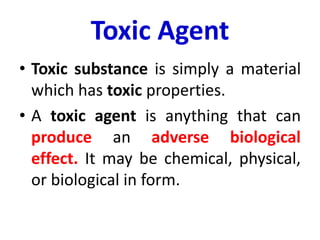
classification of toxins
- 1. Toxic Agent • Toxic substance is simply a material which has toxic properties. • A toxic agent is anything that can produce an adverse biological effect. It may be chemical, physical, or biological in form.
- 2. TOXINS Toxins are small poisonous molecules, peptides, or protein produced by plants, animals, and other organisms like viruses, fungi, bacteria, or protozoa.
- 3. NATURAL TOXINS - are chemicals that are naturally produced by living organisms. - These toxins are not harmful to the organisms themselves but they may be toxic to other creatures, including humans, when eaten. - Some plants have the capacity to naturally produce compounds that are toxic to humans when consumed.
- 4. • In other words, toxins are mostly described as drugs produced by microorganisms. They can cause diseases when absorbed by body tissues and interact with the body’s enzymes. While some toxins only cause minor discomfort and pain, some can be deadly.
- 5. CLASSIFICATION OF TOXINS • Exotoxins : toxins excreted by organisms. • Endotoxins : produced when bacteria are lysed. • Hemotoxins : are toxins that destroy red blood cells. • Phototoxins : causes one to become photosensitive (being sensitive to sunlight or ultraviolet light)
- 6. Cyanotoxins: produced by cyanobacteria; Necrotoxins: causes death of cells and destruction of tissues. Animals that have necrotoxins are brown recluse spider, puff adder; Neurotoxins can affect the nervous system (black widow spider, scorpions, box jellyfish, and cone snail)
- 7. CYTOTOXINS like ricin that is found in the castor bean plant; APITOXIN the venom of honey bees; MYCOTOXINS are produced by fungi that can be found in food; ENVIRONMENTAL TOXINS which are caused by man-made contaminants like shellfish poisoning.
- 8. POISONS • Poisons are substances that are absorbed through the skin or gut of organisms and causes chemical reactions. • It is used to describe any harmful substance, especially those that are corrosive, carcinogens, and harmful pollutants. • In other words, poisons are chemicals that can injure or impair body functions.
- 9. USES OF POISONS • Although poisons have been popularly used as methods of murder, assassination or execution. • They are also being used in pest and weed control, cleaning, maintenance, the preservation of building materials and food.
- 10. Poisons can be toxic in large doses like alcohol and some medications like aspirin and drugs that are being used in chemotherapy. Some poisons can harm certain animals while they usually do not affect other animals. Pesticides have been developed to kill certain organisms, but were later found out that they are also harmful to man.
- 11. • Toxins and poisons can have direct and indirect mechanisms of action. • Most frequently influenced organs: Liver, Kidney, Brain, Lung, intestine and other. Mechanism of action: Direct damage of tissue, effect on function, genetic defect.
- 12. Toxic substances are classified into the following: A. Heavy Metals Metals differ from other toxic substances in that they are neither created nor destroyed by humans. - plays an important role in determining their potential for health effects. - Their effect on health could occur through at least two mechanisms:
- 13. - first, by increasing the presence of heavy metals in air, water, soil, and food, and second, - by changing the structure of the chemical. For example, chromium III can be converted to or from chromium VI, the more toxic form of the metal.
- 14. B. Solvents and Vapors Nearly everyone is exposed to solvents. When a solvent evaporates, the vapors may also pose a threat to the exposed population.
- 15. C. Radiation and Radioactive Materials Radiation is the release and propagation of energy in space or through a material medium in the form of waves, the transfer of heat or light by waves of energy.
- 16. D. Dioxin/Furans Dioxin was originally discovered as a contaminant in the herbicide Agent Orange. Dioxin is also a by- product of chlorine processing in paper producing industries.
- 17. E. Pesticides The EPA defines pesticide as any substance or mixture of substances intended to prevent, destroy, repel, or mitigate any pest. & Pesticides may also be described as any physical, chemical, or biological agent that will kill an undesirable plant or animal pest.
- 18. F. Plant Toxins Different portions of a plant may contain different concentrations of chemicals. Some chemicals made by plants can be lethal. For example, taxon, used in chemotherapy to kill cancer cells, is produced by a species of the yew plant.
- 19. G. Animal Toxins These toxins can result from venomous or poisonous animal releases. Venomous animals are usually defined as those that are capable of producing a poison in a highly developed gland or group of cells, and can deliver that toxin through biting or stinging.
- 20. H. Subcategories of Toxic Substance Classifications All of these substances may also be further classified according to their: # Effect on target organs (liver, kidney, etc.), # Use (pesticide, solvent, food additive), # Source of the agent (animal and plant toxins), # Effects (cancer mutation, liver injury), # Physical state (gas, dust, liquid), # Labeling requirements (explosive, flammable, oxidizer), # Chemistry (aromatic amine, halogenated hydrocarbon), or # Poisoning potential (extremely toxic, very toxic, slightly toxic)
- 21. Thank you!